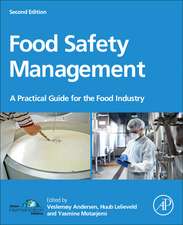Case Studies in Food Microbiology for Food Safety and Quality: Rsc
Autor Rosa K. Pawseyen Limba Engleză Paperback – 31 oct 2002
This unique book covers the key issues relating to the control and management of the most commonly occurring food borne bacteria which compromise the safety and quality of food. The 21 case studies, drawn from a wide range of sources, present real life situations in which the management of food borne pathogens failed or was at risk of failure. Each chapter contains a case study which is supported by relevant background information (such as diagrams, tables of data, etc), study questions and a subsequent feedback commentary, all of which encourage the reader to apply their knowledge. With reference to specific organisms such as E. coli, Salmonella, Listeria monocytogenes and so on, the chapters move the reader progressively from strategies for control of food borne organisms, techniques for their control, appreciating risk, through sampling criteria and acceptance, to managing risk. With the provision of real-life problems to explore, along with the opportunity to propose and justify approaches to managing food safety, this book will be welcomed as a new approach to learning not only by students and their teachers, but also by food professionals in policy-making and enforcement and the many within the food industry who are involved with the management of food safety.
Preț: 343.93 lei
Nou
Puncte Express: 516
Preț estimativ în valută:
65.82€ • 68.46$ • 54.34£
65.82€ • 68.46$ • 54.34£
Carte tipărită la comandă
Livrare economică 12-26 aprilie
Preluare comenzi: 021 569.72.76
Specificații
ISBN-13: 9780854046263
ISBN-10: 0854046267
Pagini: 490
Ilustrații: 1
Dimensiuni: 156 x 237 x 27 mm
Greutate: 0.74 kg
Editura: Royal Society Of Chemistry
Locul publicării:United Kingdom
ISBN-10: 0854046267
Pagini: 490
Ilustrații: 1
Dimensiuni: 156 x 237 x 27 mm
Greutate: 0.74 kg
Editura: Royal Society Of Chemistry
Locul publicării:United Kingdom
Cuprins
Developing Strategies for Control: Water as a Vector of Organisms; Expectations of Food Control Systems - in the Past and Now; Zoonotic Disease; Should Pasteurization of Drinking Milk be Obligatory?; Techniques for Control: Surveillance and Microbiological Analyses; Microbial Hazards; Post-production Product Handling and Acceptability; HACCP and the Responsibilities of the Food Producer; Product Formulation and Control; Risk: Views of Risk; Hazards and Risks; The Need for Food Hygiene; A Shelf Life Problem; Airline Food and Control Failure; Sampling, Criteria and Acceptance: Global Dissemination of Organisms and their Control; Extending Shelf Life - Compromising Safety?; Acceptable, Unsatisfactory and Unacceptable Concentrations of Pathogens in Ready-to-Eat Food; Managing Risk: Managing Risk; Changing a Risk Management Strategy; Hygiene Improvement at Source; What is Safe Food?; Subject Index.
Descriere
With the provision of real-life problems to explore, this book will be welcomed as a new approach to learning not only by students and their teachers but also by food professionals.
























